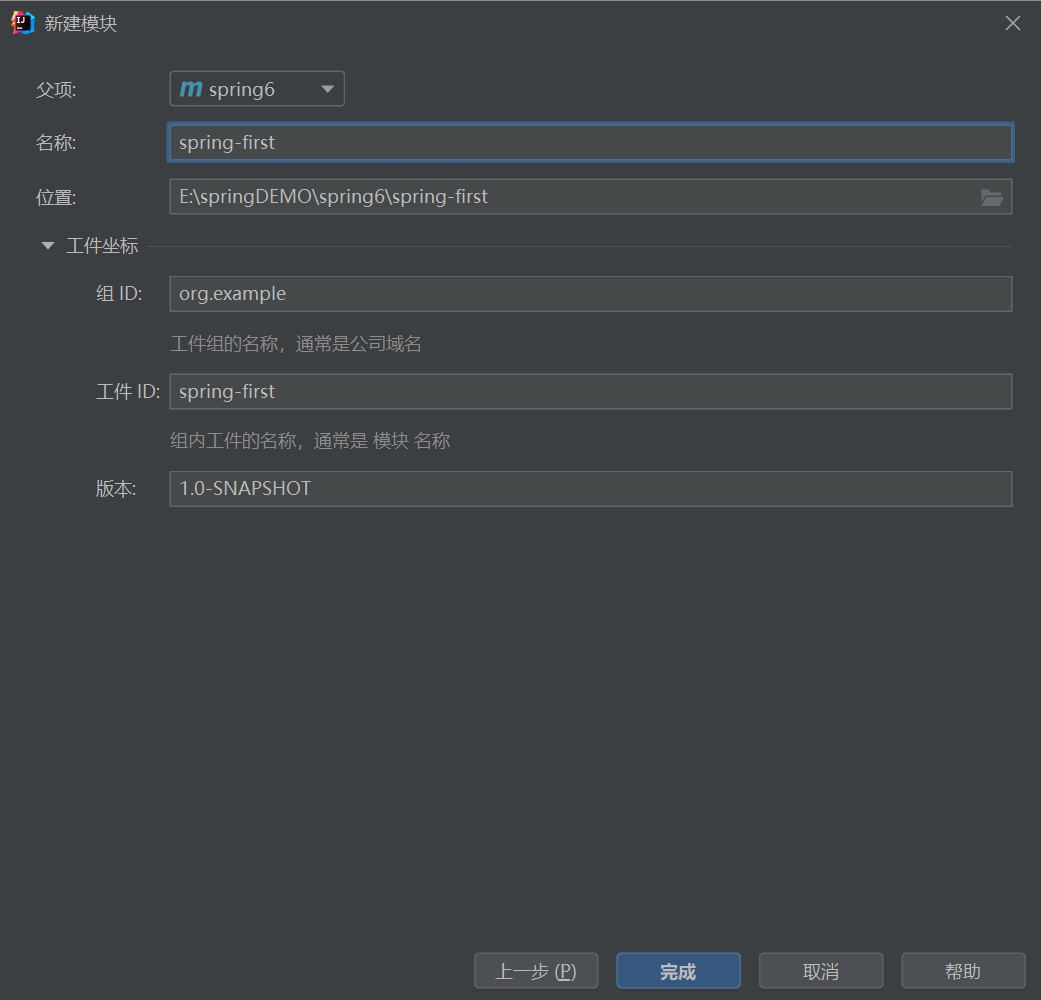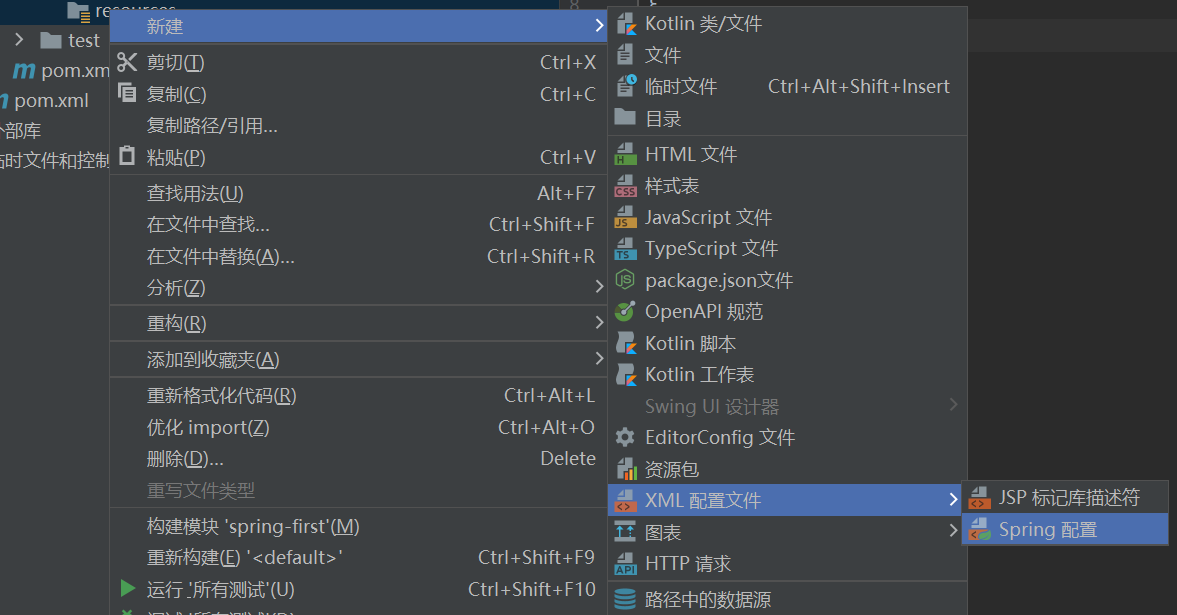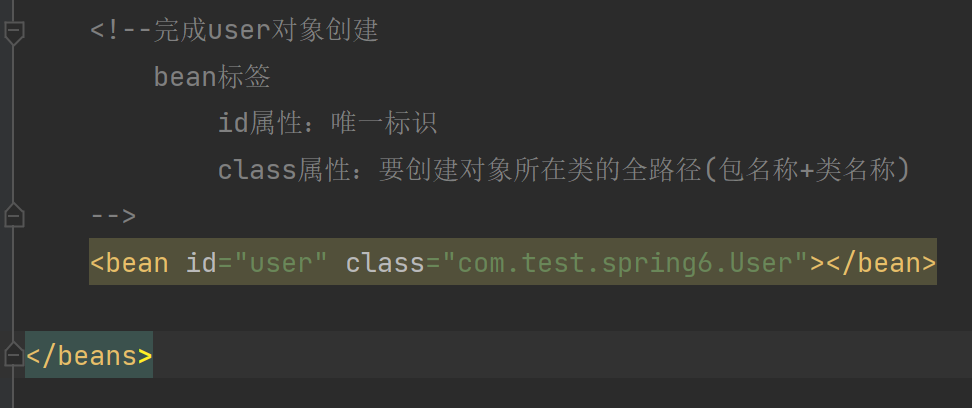创建Maven聚合工程 入门案例开发步骤 创建父工程 spring6
子模块 spring-first
第一步,引入spring相关依赖
1 2 3 4 5 6 7 8 9 10 <dependency > <groupId > org.springframework</groupId > <artifactId > spring-context</artifactId > <version > 6.0.2</version > </dependency > <dependency > <groupId > org.junit.jupiter</groupId > <artifactId > junit-jupiter-api</artifactId > <version > 5.3.1</version > </dependency >
第二步,创建类,定义属性和方法
1 2 3 4 5 6 public class User public void add () System.out.println("add..." ); } }
第三步,按照spring要求创建配置文件(xml格式)
第四步,在spring配置文件配置相关信息
第五步,进行最终测试
1 2 3 4 5 6 7 8 9 10 11 12 13 14 15 16 public class TestUser @Test public void testUserObject () ApplicationContext context = new ClassPathXmlApplicationContext("bean.xml" ); User user = (User)context.getBean("user" ); System.out.println(user); user.add(); } }
如何返回创建的对象 1.加载bean.xml配置文件
2.对xml文件进行解析操作
3.获取xml文件bean标签属性值,id属性值和class属性值
4.使用反射根据类全路径创建对象
1 2 3 4 5 6 7 8 9 @Test public void testObject1 () throws Exception Class clazz = Class.forName("com.test.spring6.User" ); User user = (User) clazz.getDeclaredConstructor().newInstance(); System.out.println(user); }
创建对象放到哪里了 查找DefaultlistableBeanFactory在下面Map集合中会存储好的对象
1 private final Map<String, BeanDefinition> beanDefinitionMap;
key:唯一标识
value:类的定义(描述信息)
Log4j2 Apache Log4j2是一个开源的日志记录组件,使用非常广泛。在工程中以易用方便代替了sout等打印语句,它是java日志输入工具
Log4j2主要由几个重要的组件构成
1.日志信息的优先级 ,日志信息的优先级从高到低有TRACE<DEBUG<INFO<WARN<ERROR<FATAL
TRACE 追踪,是最低的日志级别,相当于追踪程序的执行
DEBUG 调试,一般在开发中,都将其设置为最低的日志级别
INFO 信息,输出重要信息使用较多
WARN 警告,输出告警的信息
ERROR 错误,输出错误信息
FATAL 严重错误
级别高会自动屏蔽级别低的
2.日志信息的输出目的地 ,指定是打印控制台 还是文件中
3.日志信息的输出格式
引入Log4j2依赖 1 2 3 4 5 6 7 8 9 10 11 12 13 14 15 16 17 18 19 20 21 22 23 24 25 26 27 28 29 30 31 32 <?xml version="1.0" encoding="UTF-8"?> <configuration > <loggers > <root level ="DEBUG" > <appender-ref ref ="spring6log" /> <appender-ref ref ="RollingFile" /> <appender-ref ref ="log" /> </root > </loggers > <appenders > <console name ="spring6log" target ="SYSTEM_OUT" > <PatternLayout pattern ="%d{yyyy-MM-dd HH:mm:ss SSS} [%t] %-3level %logger{1024} - %msg%n" /> </console > <File name ="log" fileName ="e:/springDEMO/spring6_log/test.log" append ="false" > <PatternLayout pattern ="%d{HH:mm:ss.SSS} %-5level %class{36} %L %M - %msg%xEx%n" /> </File > <RollingFile name ="RollingFile" fileName ="e:/springDEMO/spring6_log/app.log" filePattern ="log/$${date:yyyy-MM}/app-%d{MM-dd-yyyy}-%i.log.gz" > <PatternLayout pattern ="%d{yyyy-MM-dd 'at' HH:mm:ss z} %-5level %class{36} %L %M - %msg%xEx%n" /> <SizeBasedTriggeringPolicy size ="50MB" /> <DefaultRolloverStrategy max ="20" /> </RollingFile > </appenders > </configuration >
测试
1 2 3 Refreshing org.springframework.context.support.ClassPathXmlApplicationContext@2d96543c Loaded 1 bean definitions from class path resource [bean.xml] Creating shared instance of singleton bean 'user'
手动使用日志 1 2 3 4 5 6 7 import org.slf4j.Logger;import org.slf4j.LoggerFactory; private Logger logger = LoggerFactory.getLogger(TestUser.class); logger.info("#####执行调用" );
IOC 基于XML管理bean 获取ben的三种方式 1 2 3 4 5 6 7 8 9 10 ApplicationContext context = new ClassPathXmlApplicationContext("bean.xml" ); User user1 = (User)context.getBean("user" ); System.out.println("根据id获取bean" + user1); User user2 = context.getBean(User.class); System.out.println("根据类型获取bean" + user2); User user3 = context.getBean("user" , User.class); System.out.println("根据id和类型获取bean" + user3);
根据类型获取bean时,要求IOC容器中指定类型的bean有且只能有一个
依赖注入 类有属性,创建对象过程中,向属性设置值
1 2 3 4 5 6 Book book = new Book(); book.setBname("php" ); book.setAuthor("李四" ); Book book1 = new Book("java" ,"张三" );
setter注入
1.创建类,定义属性,生成属性set方法
2.在spring配置文件配置
1 2 3 4 <bean id ="book" class ="com.test.spring6.iocxml.di.Book" > <property name ="bname" value ="前端开发" > </property > <property name ="author" value ="王五" > </property > </bean >
1 2 3 4 5 6 7 @Test public void testSetter () ApplicationContext context = new ClassPathXmlApplicationContext("beandi.xml" ); Book book = context.getBean("book" , Book.class); System.out.println(book); } }
构造器注入
1.创建类定义属性,生成有参构造方法
2.在spring中配置
1 2 3 4 <bean id ="bookCon" class ="com.test.spring6.iocxml.di.Book" > <constructor-arg name ="bname" value ="java开发" > </constructor-arg > <constructor-arg name ="author" value ="赵六" > </constructor-arg > </bean >
1 2 3 4 5 public void testConstrutor () ApplicationContext context = new ClassPathXmlApplicationContext("beandi.xml" ); Book book = context.getBean("bookCon" , Book.class); System.out.println(book); }
特殊值
mull
1 2 3 <property name ="other" > <null /> </property >
xml实体
1 <property name ="bname" value ="< " > </property >
CDATA节
1 2 3 <property name ="other" > <value > <![CDATA[A < B]]></value > </property >
CDATA[] 中纯文本数据 < 不会被解析
特殊类型属性注入 对象类型属性注入
为对象类型属性赋值
部门类
1 2 3 4 5 6 7 8 9 10 public class Dept private String dname; public void info () System.out.println("部门名称:" + dname); } }
员工类
1 2 3 4 5 6 7 8 9 10 11 12 13 14 public class Emp private Dept dept; private String ename; private Integer age; public void work () System.out.println(ename + "emp work" +age+ "岁" ); dept.info(); } }
1.引用外部bean
1 2 3 4 5 6 7 8 9 10 11 12 13 <bean id ="dept" class ="com.test.spring6.iocxml.ditest.Dept" > <property name ="dname" value ="安全部门" > </property > </bean > <bean id ="emp" class ="com.test.spring6.iocxml.ditest.Emp" > <property name ="ename" value ="张三" > </property > <property name ="age" value ="50" > </property > <property name ="dept" ref ="dept" > </property > </bean >
2.引用内部bean
1 2 3 4 5 6 7 8 9 10 <bean id ="emp" class ="com.test.spring6.iocxml.ditest.Emp" > <property name ="ename" value ="张三" > </property > <property name ="age" value ="51" > </property > <property name ="dept" > <bean id ="dept" class ="com.test.spring6.iocxml.ditest.Dept" > <property name ="dname" value ="安全部门" > </property > </bean > </property > </bean >
3.级联属性赋值
1 2 3 4 5 6 7 8 9 10 11 <bean id ="dept" class ="com.test.spring6.iocxml.ditest.Dept" > <property name ="dname" value ="技术部门" > </property > </bean > <bean id ="emp" class ="com.test.spring6.iocxml.ditest.Emp" > <property name ="ename" value ="张三" > </property > <property name ="age" value ="52" > </property > <property name ="dept" ref ="dept" > </property > <property name ="dept.dname" value ="测试部门" > </property > </bean >
数组类型注入
1 2 3 4 5 6 7 8 <property name ="loves" > <array > <value > like1</value > <value > like2</value > <value > like3</value > </array > </property >
集合类型注入
1.部门类添加集合private List<Emp> empList;
2.在部门方法中添加遍历员工姓名方法for (Emp emp:empList){System.out.println(emp.getEname());}
3.spring配置文件中,使用<list>和 <ref>标签
1 2 3 4 5 6 7 8 9 10 11 12 13 14 15 <bean id ="dept" class ="com.test.spring6.iocxml.ditest.Dept" > <property name ="dname" value ="网络部" > </property > <property name ="empList" > <list > <ref bean ="emp1" > </ref > <ref bean ="emp2" > </ref > </list > </property > </bean > <bean id ="emp1" class ="com.test.spring6.iocxml.ditest.Emp" > <property name ="ename" value ="lisi" > </property > </bean > <bean id ="emp2" class ="com.test.spring6.iocxml.ditest.Emp" > <property name ="ename" value ="wangwu" > </property > </bean >
Map类注入
private Map<String,Teacher> teacherMap;
1 2 3 4 5 6 7 8 <map > <entry > <key > <value > 1111</value > </key > <ref bean ="text" > </ref > </entry > </map >
引用集合类型
添加约束
1 2 3 4 5 6 7 8 <?xml version="1.0" encoding="UTF-8"?> <beans xmlns ="http://www.springframework.org/schema/beans" xmlns:xsi ="http://www.w3.org/2001/XMLSchema-instance" xmlns:util ="http://www.springframework.org/schema/util" xsi:schemaLocation ="http://www.springframework.org/schema/util http://www.springframework.org/schema/beans/spring-util.xsd http://www.springframework.org/schema/beans http://www.springframework.org/schema/beans/spring-beans.xsd" >
bean的作用域 bean的生命周期 










